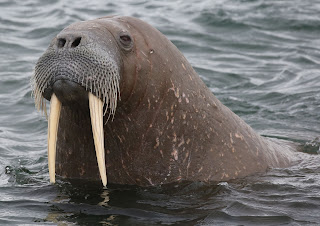Walrus!
The Walrus (Odobenus rosmarus) is a large flipper-ed marine mammal, with a discontinuous Arctic distribution. There are two populations in the Pacific & Atlantic Oceans. The animals around Svalbad are of the smaller Atlantic race O.R. rosmarus.
These males are resting on shore.
This Atlantic population of Walrus is much smaller in numbers than the Pacific one. This race ranges across Arctic Canada, Greenland, Svalbad & western Arctic Russia. The Svalbad population breeds then the females & young move eastwards to the edge of the pack ice. All the above photographs are of males in western Svalbad.
These animals were just playing in the shallows.
Walruses can live to up to 30 years old, the males becoming sexually mature at around seven years old but are often prevented from mating by older males. Many males are 15 years old before they mate for the first time. females come into season around six years old.
The tusks are elongated canines & are present in both sexes. The tusks on males tend to be larger, growing up to a metre in length & weighing up to 5.4 kgs. They are used for fighting in dominance & display.
Surrounding the tusks are a mat of stiff bristles which are very sensitive & used for foraging on the ocean floor.
Their blubber can be up to 15cm thick & as animals get older they get paler, some very old males appearing almost pink!
These animals were rubbing their skin
along pebbly portions of the shallow bay.
Walrus are easily affected by noise & disturbance
by humans. Stampedes occur regularly.
by humans. Stampedes occur regularly.
Atlantic Walrus rest on shore, rather than
on the pack ice itself.
on the pack ice itself.
Numbers of Walrus were greatly reduced by over hunting in the last century. Populations are slowly recovering but the Svalbad population is only around 2,500 animals. The greatest threat to Walrus today is climate change.






























No comments:
Post a Comment